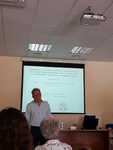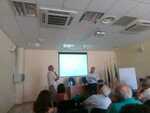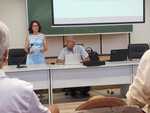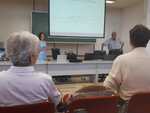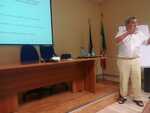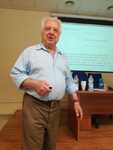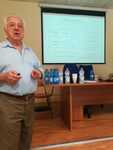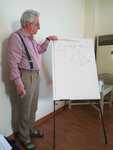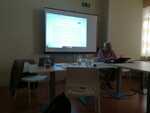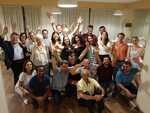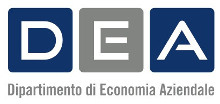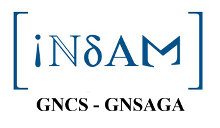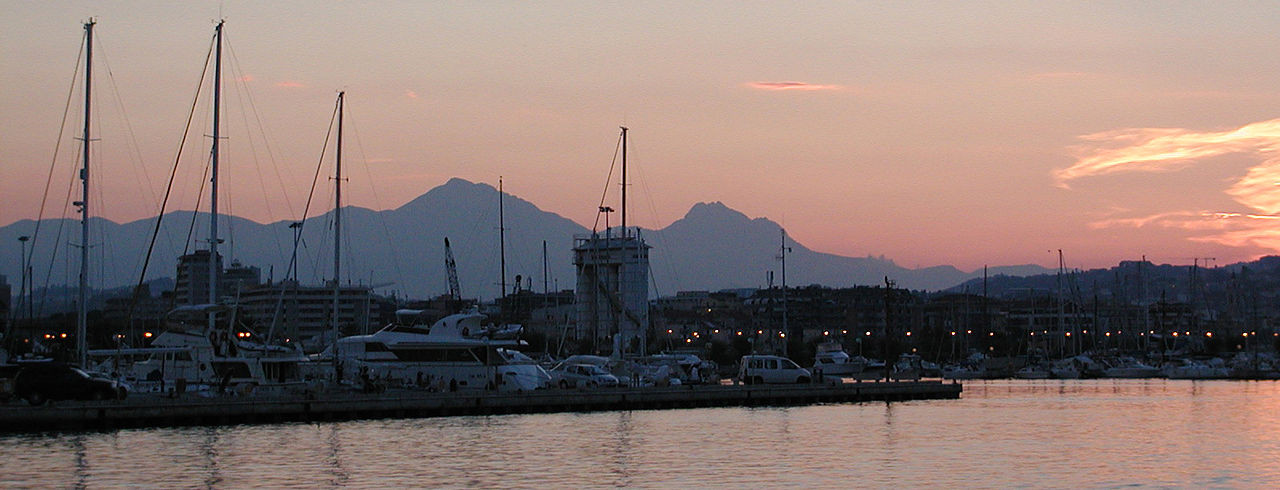
6th Ph.D. School/Conference on
Mathematical Modeling of Complex Systems
Università
“G. d’Annunzio”, Pescara (IT), July 3 – 11, 2019
Presentation
This is the latest in a series of events that started at the University of Patras, Greece, in Julyy 11. The previous editions were:
- University of Patras, Greece, July 2011
- Università “G. d’Annunzio”, Pescara, July 2012
- Technological Educational Institute of Crete, Heraklion, Greece, July 2013
- CulturalFoundation “Kritiki Estia”, Athens, Greece, July 2014
- University of Patras, Greece, July 2015
This year’s event is dedicated to the memory of Professor Gregoire Nicolis, of the Université Libre de Bruxelles, who recently passed away. Professor Nicolis, one of the founding fathers and most influential advocates of Complexity Science, was an invited speaker in the Conference on Nonlinear Science and Complexity at Pescara, July 2009 (see his presentation).
The focus of the 6th Ph.D. School/Conference this year is on the connections between Information Theory and Complexity through the fundamental role of Entropy. It is primarily intended for postgraduate (and advanced undergraduate) students primarily from European countries (but students from other countries are also invited to apply) and offers four coherent lecture modules, taught by experts in each field, on:
- Fundamental Concepts of Complexity in Physical Systems
A. Bountis (Astana), M. Robnik (Maribor), Ch. Skokos (Cape Town), M. G. Velarde (Madrid), J. P. van der Weele (Patras) - Complexity in Biomedical Sciences
A. Athanassiadou (Patras), V. Basios (Brussels), A. Bezerianos (Singapore/Patras), A. S. Fokas (Cambridge), A. Piattelli (Chieti-Pescara), A. Mandilara (Nur-Sultan) - Entropy and Information Theory
D. P. K. Ghikas (Patras), G. Pistone (Torino), S. Puechmorel (Toulouse), C. Tsallis, (Rio de Janeiro) J. J. P. Veerman (Portland)
Scientific Organizing Committee
- G. Amato (Università “G. d’Annunzio”, Pescara)
- A. Bountis (Nazarbayev University, Astana)
- A. De Sanctis (Università “G. d’Annunzio”, Pescara)
- S. A. Gattone (Università “G. d’Annunzio”, Pescara)
- C. Mari (Università “G. d’Annunzio”, Pescara)
- M. Parton (Università “G. d’Annunzio”, Pescara)
- A. Piattelli (Università “G. d’Annunzio”, Pescara)
- J. J. P. Veerman (Portland State University)
- M. G. Velarde (Complutense University of Madrid)
- J. P. van der Weele (University of Patras)
Speakers
- Chris Antonopoulos (University of Essex)
- Aglaia Athanassiadou (University of Patras)
- Vasileios Basios (University of Brussels)
- Tassos Bezerianos (University of Singapore)
- Tassos Bountis (University of Astana)
- Athanassios Fokas (University of Cambridge)
- Demetris Ghikas (University of Patras)
- George Livadiotis (Southwest Research Institute)
- Aikaterini Mandilara (Nazarbayev University)
- Giovanni Pistone (University of Torino)
- Marko Robnik (University of Maribor)
- Charalampos Skokos (University of Cape Town)
- Costantino Tsallis (University of Rio de Janeiro)
- Peter Veerman (University of Portland)
- Manuel Velarde (University of Madrid)
- Ko van der Weele (University of Patras)
(Download the PDF version of the schedule)
July 1: A tutorial on Information Flow in Directed Graphs I (Classroom 30)
10:15-11:45, Peter Veerman (Portland): Mathematical Background: Perron-Frobenius, Jordan Normal Form, Cauchy-Binet, Jacobi’s Formula (slides)
12:00-13:30, Peter Veerman (Portland): Diffusion and Consensus on Digraphs (slides)
15:00-17:00, Mario Eboli (Chieti-Pescara)
July 2: A tutorial on Information Flow in Directed Graphs II (Classroom 30)
10:15-11:45, Peter Veerman (Portland): Applications: Pagerank, Contagion, Ford-Fulkerson (slides)
12:00-13:30, Peter Veerman (Portland): The Matrix Tree Theorem (slides)
15:00-17:00, Luca Moscardelli (Chieti-Pescara): COEVOLUTIONARY AND AGGREGATION-BASED OPINION FORMATION PROCESS
July 3: Fundamental Concepts of Complexity (Aula Rossa)
Morning Session 09:30 – 13:30
Chairwoman: A. De Sanctis
09:30-09:45, Greetings and opening remarks
09:45-10:45, Tassos Bountis (Patras and Astana): COMPLEX DYNAMICS AND STATISTICS OF 1-DIMENSIONAL HAMILTONIAN LATTICES I (slides)
Coffee break
11:15-12:45, Vasileios Basios (Brussel): FOUNDING COMPLEXITY SCIENCE: THE WORK OF GREGOIRE NICOLIS (slides)
13:00-13:30, Aglaia Athanassiadou (Patras): THE GENETIC COMPLEXITY OF THE HUMAN GENOME IN HEALTH AND DISEASE (slides)
Afternoon Session 15:00 – 18:00
Chairman: D. Ghikas
15:00-15:45, Peter Veerman (Portland): DIFFUSION AND CONSENSUS ON WEAKLY CONNECTED DIRECTED GRAPHS (slides on diffusion and consensus) (slides on applications)
Coffee break
16:00-18:00, Tassos Bezerianos (Patras and Singapore): GRAPH THEORY MODELS REPRESENT COGNITIVE PROCESSES IN THE BRAIN I
July 4: Complexity in Biomedicine (Aula Rossa)
Special Session
FROM THE TREATMENT OF SMALL DEFECTS TO THE TREATMENT OF THE EXTREME ATROPHY OF THE JAWS
July 5: Complexity Physical and Biological Sciences (Classroom 4)
Morning Session 09:30 – 13:30
Chairman: M. Robnik
09:30-11:30, Tassos Bountis (Patras and Astana): COMPLEX DYNAMICS AND STATISTICS OF 1-DIMENSIONAL HAMILTONIAN LATTICES II (slides)
Coffee break
12:00-13:30, Aikaterini Mandilara (Astana): ENTROPY AND COMPLEXITY IN QUANTUM INFORMATION: BASIC PARADIGMS
Afternoon Session 15:00 – 17:00
Chairman: T. Bountis
15:00-17:00, Tassos Bezerianos (Patras and Singapore): GRAPH THEORY MODELS REPRESENT COGNITIVE PROCESSES IN THE BRAIN II
Coffee break
Short Presentations 17:30 – 19:30
17:30-18:00, Jordan McKittrick (University of Cambridge): When is entropy finite? Inference in the absence of information.
18:00-18:30, Bootan Rahman (University of Kurdistan Hewlêr): SOME APPLICATIONS OF TIME DELAY SYSTEMS (slides)
18:30-19:00, Konstantinos Tsampourakis (Washington State University): Pattern formation in a multi agent system.
19:00-19:30, Houtalonis Joannis (National Kapodistrean university of Athens): A step further in investigating earthquake coda waves in terms of non extensive statistical physics.
July 8: Nonlinear Mathematical Science (Aula Rossa)
Morning Session 09:15 – 13:30
Chairman: T. Bountis
09:15-11:15, Marko Robnik (Maribor): QUANTUM CHAOS OF GENERIC SYSTEMS (slides)
Coffee break
11:30-13:30, Ko van der Weele (Patras): NONLINEAR WAVES: THE DYNAMICAL SYSTEMS APPROACH
Afternoon Session 15:00 – 18:45
Chairman: P. Veerman
15:00-17:00, Manuel Velarde (Madrid): NONLINEAR DYNAMICS AT THE MICRO AND NANO SCLAES (FLUIDS, SOLIDS)
Coffee break
17:15-18:45, Haris Skokos (Cape Town): CHAOTIC BEHAVIOR OF MULTIDIMENSIONAL HAMILTONIAN SYSTEMS: Disordered lattices, Granular Chains and DNA models (slides)
July 9: Complexity in Physical Systems (Classroom 4)
Morning Session 09:30 – 13:30
Chairman: T. Bezerianos
9:30-11:30, Athanassios Fokas (Cambridge): MATHEMATICAL METHODS OF BRAIN IMAGING: NEW RESULTS ON THE ANALYSIS OF PET, SPECT, MEGG AND EEG TECHNIQUES
Coffee break
12:00-13:00, George Livadiotis (Southwest USA): THEORY OF KAPPA DISTRIBUTIONS AND NONEXTENSIVE STATISTICAL MECHANICS: APPLICATIONS IN ASTROPHYSICAL PLASMAS
13:00-13:30, Maria Christina Van der Weele (Cambridge): INTEGRABLE SYSTEMS IN 4+2 DIMENSIONS AND THEIR REDUCTION TO 3+1 DIMENSIONS
Afternoon Session 15:00 – 18:30
Chairman: D. Ghikas
15:00-17:00, Athanassios Fokas (Cambridge) Plenary Talk: ASSOCIATIONS: VISUAL PERCEPTION AND REDUCTION VERSUS UNIFICATION
Coffee break
Poster Session 17:30 – 18:30
Dario Simoncini (Pescara): WORKING WITH COMPLEXITY: ENABLING ORGANIZATIONAL ENVIRONMENT (slides)
July 10: Entropy and Complexity (Classroom 4)
Morning Session 09:30 – 13:30
Chairman: T. Bezerianos
09:30-11:30, Costantino Tsallis (Rio de Janeiro): BEYOND BOLTZMANN-GIBBS IN PHYSICS, MATHEMATICS AND ELSEWHERE (slides)
Coffee break
12:00-13:30, Chris G. Antonopoulos (Essex): (to be defined)
Afternoon Session 15:00 – 18:30
Chairman: P. Veerman
15:00-16:00, Demetris Ghikas (Patras): FROM COMPLEXITY TO INFORMATION GEOMETRY
Coffee break
16:30-18:30, Giovanni Pistone (Torino): GEOMETRY OF THE PROBABILITY SIMPLEX I
July 11, 2019: Information Geometry (Aula Rossa)
Morning Session 09:30 – 13:00
Chairman: D. Ghikas
09:30-11:30, Giovanni Pistone: GEOMETRY OF THE PROBABILITY SIMPLEX II
Coffee break
12:00-12:45, Angela De Sanctis, Antonio Gattone (Pescara): A SHAPE DISTANCE BASED ON THE FISHER-RAO METRIC AND ITS APPLICATION FOR SHAPE CLUSTERING
13:00-13:30, School closing
University of Patras, Greece
The Genetic Complexity of the Human Genome in Health and Disease.
The Human Genome Project refers to the determination of the DNA sequence of the 23 chromosome pairs- the haploid genome consists of 3x10 9 base pairs-and the small molecule of the mitochondrial DNA in humans. Completion of the Human Genome Project's sequencing effort, was announced in 2003 by The Human Genome Project and the Celera Corporation and this opened up the way of a deeper understanding of cell function in health and disease. The Human Genome contains specific DNA entities: genes are in the area 19.000-20.000, protein-coding sequences represent a very small fraction (approx.1.5%), while the rest of the genome is associated with introns, regulatory DNA sequences, repetitive DNA sequences, non-coding RNA genes and sequences of yet unknown function. Genome architecture is facilitated by specifiic genome organisers and gene ‘landscapes’ have been identified with reference to complex cell processes, eg the Development, as well as to multifactorial diseases eg Cancer, advancing our understanding of their physiology and their interconnections.
Université Libre de Bruxelles
Founding Complexity Science: the work of Gregoire Nicolis.
Department of Mathematics – Nazarbayev University, Republic of Kazakhstan
Complex Dynamics and Statistics of 1D Hamiltonian Lattices.
In these lectures, I will focus on one class of phenomena, which may be called "complex" in the sense that they deviate from what common wisdom expects. Our first discovery is that all types of chaotic behavior are not qualitatively the same. Indeed, very close to the boundaries of regular motion, where Lyapunov exponents are small and orbits exhibit "stickiness" effects, the statistics of averaged position (or momentum) sums is strongly correlated and probability density functions (pdfs) are not described by pure Gaussians, associated with what we call "strong chaos" and Boltzmann Gibbs (BG) statistical mechanics. Instead, the pdfs are well approximated by q (>1) – Gaussians (q=1 being the pure Gaussian), suggesting that their proper description is not through the classical BG entropy SBG, but rather via Tsallis' non-additive (and generally non-extensive) Sq entropy, associated by what one might call "weak chaos".
Department of Applied Mathematics and Theoretical Physics – University of Cambridge, Cambridge UK
Associations: visual perception and reduction versus unification.
Visual perception is achieved via associating different aspects of the integration of the mental representations of the constituent parts of this percept, the innate quest for understanding urges the brain to “undo” this integration, and to attempt to reduce an object or a concept into its building blocks. This process of reduction is of fundamental importance not only in sciences, but also in arts, as exemplified by the works of Piet Mondrian, Kazimir Malevich, and Mark Rothko. Second, the brain not only associates different aspects of the same percept or concept but can also associate different concepts. Associations of this type characterize the work of great minds from Einstein to Picasso and Giacometti. The relentless pursuit of the brain for unifying different concepts, expresses itself with the tendency of humans to construct unified theories, as exemplified in Physics
University of Patras, Greece
From Complexity to Information Geometry and Beyond
Complex Systems are ubiquitous in nature and man-made systems. In natural sciences, in social and economic models and in mathematical constructions are studied and analyzed, are applied in practical problems but without a clear and universal definition of “complexity”, let alone classification and quantification. Following the “three-level scheme” of physical theories, observations/experiments, phenomenology, microscopic interactions, we need, starting from the experience of observation to establish appropriate phenomenological parameters and concepts, and in conjunction with a possible knowledge of the nature of microscopic structures to deepen our understanding of a particular system which we “understand as complex”. Information Geometry seems to be a useful phenomenological framework, which using generalized entropies, provides some classification and quantification tools. But we need the next level, the microscopic structure and interactions of the parts of complex systems. A useful direction is the conceptual niche of hyper-networks and super graphs, where a strong involvement of algebra offers concrete techniques. We believe that appropriate algebraic structures may systematize our approach to the microscopic structures of complex systems, and help associate the information geometric phenomenology with concrete properties. In this talk after a short discussion of the problem of “definition of complexity”, we introduce our information geometric quantities derived from generalized entropies. Then we present our results of the application of information geometry for the classification of complex systems. Finally we present our ideas for an abstract algebraic approach which may offer a framework for the study of the microscopic study of complex systems.
Southwest Research Institute, USA
Theory of Kappa distributions and nonextensive statitsical mechanics: applications in astrophysical plasmas.
Classical collisional particle systems residing in thermal equilibrium have their particle velocity/energy distribution function stabilized into a Maxwell-Boltzmann distribution. On the contrary, space and astrophysical plasmas are exotic collisionless particle systems residing in stationary states characterized by the so-called kappa distributions. A breakthrough in the field came with the connection of kappa distributions with statistical mechanics and thermodynamics, accomplished by the following two findings: (i) kappa distributions maximize the entropy of nonextensive statistical mechanics under the constraints of canonical ensemble, and (ii) particle systems exchanging heat with each other reaching thermodynamic equilibrium are stabilized always into a kappa distribution. Thereafter, kappa distributions became increasingly widespread across the physics of astrophysical plasma processes, describing particles in the heliosphere, from the solar wind and planetary magnetospheres to the heliosheath and beyond, the interstellar and intergalactic plasmas. The lecture will review the physical foundations and recent developments of kappa distributions in space and astrophysical plasmas.
Physics Department – Nazarbayev University
Entropy and Complexity in Quantum Information: basic paradigms
Quantum information and Computation [1] is an interdisciplinary area of research that has lately attracted a lot of attention. In the first part of this lecture, the basic mathematics of quantum mechanics [2] will be introduced and with their help, the postulates of quantum mechanics, quantum states, observables and measurements, will be explained. Going one step further, the basic `themes’ of quantum information (qubits, quantum channels, gates and circuits) will be presented (qubits, quantum channels, gates and circuits), via simple examples or protocols.
Complexity and entropy are essential in this field. Thus, in the second part of this presentation basic examples of the use of these notions will be analyzed. More precisely, we will start with the entropy [1], as a quantifier of quantum information and proceed with the entropic uncertainty relations [3], where entropy quantifies the uncertainty in the outcome of a quantum measurement given a state and an observable. Then, we will turn our attention to quantum computing and different kinds of complexity will be introduced [4] that are relevant to quantum algorithms. Finally, some comments will be made concerning the quantum Kolmogorov entropy of states [5] and its use in characterizing and analyzing the notion of entanglement.
References:
[1] Michael A. Nielsen and Isaac L. Chuang, “Quantum Computation and Quantum Information”, Cambridge University Press, Cambridge (2010).
[2] David McMahon, Quantum Computing Explained, Wiley-IEEE Computer (2007)
[3] Iwo Bialynicki-Birula and Łukasz Rudnicki “Entropic Uncertainty Relations in Quantum Physics”, In: Sen, K.D. (ed.): StatisticalComplexity, pp. 1–34 (Springer, Berlin, 2011)
[4] R. Cleve, “An Introduction to Quantum Complexity Theory”, https://cds.cern.ch/record/392006/files/9906111.pdf
[5] C. Mora, H. Briegel, B. Kraus, “Quantum Kolmogorov complexity and its applications”, International Journal of Quantum Information vol 5, pp. 729-750 (2007).
Dipartimento di Economia – Università di Chieti-Pescara
Coevolutionary and aggregation-based opinion formation processes.
Studies of social sciences have emphasised the role of interpersonal relations in how people form their opinions. Therefore, an active line of research work in social science and artificial intelligence, which build on the model of DeGroot and on a revised version due to Friedkin and Johnsen, have modelled the formation of opinions as a dynamic process in a social network in which the agents form their judgments based both on an innate attitude and on the behaviour of the neighbours in the network. The central problems about which much of the current literature revolves are the problem of finding the minimal conditions which guarantee the convergence of the process to a consensus of opinions and the problem of determining the properties of the stable outcomes (not necessarily a consensus). The latter problem is typically tackled by making use of AGT tools. In our talk we present an overview of the area and introduce some recent progresses with special focus on the coevolutionary settings and on a general model of opinion formation based on aggregation mechanisms. In a coevolutionary setting we generally assume that the environment (made of the social relationships, the intrinsic attitude of the agents, etc), co-evolve in a cross-influencing manner with the opinions. In an opinion formation model base on aggregation mechanisms agents form their opinions by locally aggregating the opinions of the neighbours by using a particular aggregation method.
Collegio Carlo Alberto – Università degli Studi di Torino
Geometry of the probability simplex
The probability simplex on a finite state space can be viewed as the support of various geometric structures e.g., it is an affine space, and a general exponential family, and a Riemannian manifold, and a metric space for the Kantorovich-Rubinstein distance. I will give a rigorous presentation of all these structures based on the general idea of Statistical Bundle. Cases were the sample space is infinite will be mentioned from the conceptual point of view with emphasis on the Gaussian case. The aim is to provide a self-contained critical introduction to the recent monograph by Shun-Ichi Amari "Information Geometry and its applications", Springer 2016. Applications to Statistics, Information Theory, Machine Learning, Lagrangian Mechanics will be discussed.
Center for Applied Mathematics and Theoretical Physics (CAMTP) – University of Maribor
Quantum chaos of generic systems
Quantum chaos (or wave chaos) is a research field in theoretical and experimental physics dealing with the phenomena in the quantum domain (especially regarding solutions of the Schroedinger equation), or in other wave systems, which correspond to the classical chaos [1,2,8]. These other wave systems are electromagnetic, acoustic, elastic, surface, seismic, gravitational waves, etc. The classical dynamics describes the ”rays” of the underlying waves, and the bridge between the classical and quan- tum mechanics is the semiclassical mechanics, resting upon the short-wavelength approximations. If the classical dynamics is chaotic, we see clear signatures in the quantum (wave) domain, e.g. in statistical properties of discrete energy spectra, in the structure of eigenfunctions, and in the statistical properties of other observ- ables. Quantum chaos occurs in low-dimensional systems, e.g. with just two degrees of freedom (e.g. in 2D billiards), but of course also in multi-dimensional systems. From the above it is obvious that theory and experiment in quantum chaos are of fundamental importance in physics, and, moreover, also in technology.
Department of Mathematics and Applied Mathematics – University of Cape Town
Chaotic Behavior of Multidimensional Hamiltonian Systems: Disordered lattices, Granular Chains and DNA models
In this talk I will present results on the chaotic behavior of several disordered, nonlinear Hamiltonian systems, emphasizing the quantification of chaos strength through the computation of the maximum Lyapunov exponent (mLE, see for example [1] and references therein). Initially, I will discuss the dynamics of the disordered variants of two typical lattice models: the Klein-Gordon oscillator chain and the discrete nonlinear Schrödinger equation. At first, I will explain how one can use symplectic integration schemes for the efficient integration of the equations of motion, as well as the variational equations (needed for the computation of the mLE) of these models [2-7]. Then, I will present results concerning the chaoticity of these systems. In particular, I will focus on the time evolution of the mLE and the distribution of the associated deviation vector. I will emphasize the fact that the observed power law decays of the mLE have exponents different from -1, which is seen in the case of regular motion [8, 9]. This is a clear indication that the dynamics becomes less chaotic, since the constant total energy/norm of the system is shared among more sites, but it does not show any sign of crossing over to regular motion, which could imply a potential halt of spreading. The fact that the same dynamical behaviors are observed for both models signifies the generality of the underlying chaotic mechanisms.
CBPF — Santa Fe Institute — Complexity Science Hub Vienna
Beyond Boltzmann-Gibbs-Shannon in Physics, Mathematics and elsewhere.
Diffusion and consensus on weakly connected directed graphs
We outline a complete and self-contained treatment of the asymptotics of (discrete and continuous) consensus and diffusion on directed graphs. Let $G$ be a weakly connected directed graph with directed graph Laplacian ${\cal L}$. In many or most applications involving digraphs, it is possible to identify a direction of flow of information. We fix that direction as the direction of the edges. With this convention, consensus (and its discrete-time analogue) and diffusion (and its discrete-time analogue) are dual to one another in the sense that $\dot x=-{\cal L}x$ for consensus, and $\dot p=-p{\cal L}$ for diffusion. As a result, their asymptotic states can be described as duals. We give a precise characterization of a basis of row vectors $\{\bar \gamma_i\}_{i=1}^k$ of the left null-space of ${\cal L}$ and of a basis of column vectors $\{\gamma_i\}_{i=1}^k$ of the right null-space of ${\cal L}$. This characterization is given in terms of the partition of $G$ into strongly connected components and how these are connected to each other. In turn, this allows us to give a complete characterization of the asymptotic behavior of both diffusion and consensus in terms of these eigenvectors. As an application of these ideas, we present a treatment of the pagerank algorithm that is dual to the usual one, and give a new result that shows that the \emph{teleporting} (see below) feature usually included in the algorithm actually does not add information.
(slides on diffusion and consensus) (slides on applications)
Department of Mathematics – University of Patras
Nonlinear waves: the dynamical systems approach
1. WAVES IN SHALLOW WATER
In this first lecture, the Dynamical Systems method of finding nonlinear traveling waves is introduced by means of a classic example: the Korteweg-deVries (KdV) equation, describing waves of long wavelength in relatively shallow water. The famous soliton solution, as well as the cnoidal waves, are found to correspond to closed orbits in phase space. By the same method we analyze a higher-order KdV equation introduced by A.S. Fokas in 1995, the solutions of which turn out to correspond more closely to actual experiments than those of the original KdV equation.
Time permitting, we will employ the Dynamical Systems approach also to other types of nonlinear waves, e.g. the shock waves that arise in the context of the Burgers equation used to describe gas dynamics and traffic flow.
2. WAVES IN FLOWING GRANULAR MATTER
The second lecture is devoted to surface waves in granular chute flow, which is encountered in innumerable industrial applications as well as in the natural environment in the form of devastating landslides and rock avalanches. We examine the succession of traveling waveforms that appear for growing Froude number Fr. Generally, for Fr < 2/3 one finds either a uniform flow of constant thickness or a monoclinal flood wave, i.e., a shock structure monotonically connecting a thick region upstream to a shallower one downstream. For Fr > 2/3 both the uniform flow and the monoclinal wave cease to be stable; the flow now organizes itself in a train of roll waves. On the basis of the governing granular Saint-Venant equations, we derive a dynamical system that elucidates the transition from monoclinal waves to roll waves. It is found that this transition involves a wealth of intermediate stages, including an undular bore that had hitherto not been reported for granular flows.
Department of Applied Mathematics and Theoretical Physics (DAMTP) – University of Cambridge
Integrable systems in 4+2 dimensions and their reduction to 3+1 dimensions
One of the main current topics in the field of integrable systems concerns the existence of nonlinear integrable evolution equations in more than two spatial dimensions. The fact that such equations exist has been proven by A.S. Fokas [1], who derived equations of this type in four spatial dimensions, which however had the disadvantage of containing two time dimensions. The associated initial value problem for such equations, where the dependent variables are specified for all space variables at t1 = t2 = 0, can be solved by means of a nonlocal d-bar problem.
The next step in this program is to formulate and solve nonlinear integrable systems in 3+1 dimensions (i.e., with three space variables and a single time variable) in agreement with physical reality. The method we employ is to first construct a system in 4+2 dimensions, which we then aim to reduce to 3+1 dimensions.
In this talk we will focus on the Davey-Stewartson system [2] and the 3-wave interaction equations. Both these integrable systems have their origins in fluid dynamics where they describe the evolution and interaction, respectively, of wave packets on e.g. a water surface. We start from these equations in their usual form in 2+1 dimensions (two space variables x, y and one time variable t) and we bring them to 4+2 dimensions by complexifying each of these variables. We solve the initial value problem of these equations in 4+2 dimensions. Subsequently, in the linear limit we reduce this analysis to 3+1 dimensions to comply with the natural world. Finally, we discuss the construction of the 3+1 reduction of the full nonlinear problem, which is currently under investigation.
This is joint work together with my PhD supervisor Prof. A.S. Fokas.
References
[1] A.S. Fokas, Integrable Nonlinear Evolution Partial Differential Equations in 4+2 and 3+1 Dimensions, Phys. Rev. Lett. 96 (2006), 190201.
[2] A.S. Fokas and M.C. van der Weele, Complexification and integrability in multidimensions, J. Math. Phys. 59 (2018), 091413.
How to apply
Postgraduate or advanced undergraduate students aiming to obtain a Master’s or Ph.D. degree in any scientific area involving Complex Systems are invited to apply to Prof. Angela De Sanctis, at a.desanctis@unich.it. Each applicant is asked to submit a CV, including a transcript of grades obtained in his/her undergraduate studies, as well as a personal statement explaining why the School will be useful to his/her current studies, including names and contact information of two senior scientists recommending the applicant.
Based on the above information, the Scientific Organizing Committee will select 35 - 40 applicants to attend the School. To obtain a Certificate of Participation the selected students should attend all lectures and exercise sessions of the School. The total number of instruction hours is nearly 28, which corresponds to 3 ECTS credits, as stated on the Certificate that each student receives.
All interested students are invited to submit their application at the latest by May 31, 2019. They will then be informed about the decision of the Scientific Organizing Committee regarding their acceptance. The selected students will be asked to download and read preparatory material provided by the instructors and placed on the School’s website. In this way, the students will be better prepared to follow the lectures and exercise sessions of the School.
Attendance fee, living expenses and financial support
The attendance fee for each student participating in the Ph.D. School is € 150. Limited financial support can be provided to deserving students after sufficient justification. The attendance fee includes:
- Participation in all lectures and exercise sessions
- All printed material related to the Ph.D. School
- Participation in all the School’s social activities
- Coffee breaks during the School
Comfortable, low-cost double rooms will be provided to the students at a seaside hotel in Pescara.
| # | Name | Affiliation |
|---|---|---|
| Speakers | ||
| 1 | Chris G. Antonopoulos | University of Essex |
| 2 | Aglaia Athanassiadou | University of Patras |
| 3 | Vasileios Basios | University of Brussels |
| 4 | Tassos Bezerianos | University of Singapore |
| 5 | Tassos Bountis | University of Astana |
| 6 | Angela De Sanctis | Università di Chieti-Pescara |
| 7 | Athanassios Fokas | University of Cambridge |
| 8 | Antonio Gattone | Università di Chieti-Pescara |
| 9 | Demetris Ghikas | University of Patras |
| 10 | George Livadiotis | Southwest Research Institute |
| 11 | Aikaterini Mandilara | Nazarbayev University |
| 12 | Giovanni Pistone | University of Turin |
| 13 | Marko Robnik | University of Maribor |
| 14 | Haris Skokos | University of Cape Town |
| 15 | Costantino Tsallis | University of Rio de Janeiro |
| 17 | Peter Veerman | University of Portland |
| 16 | Manuel Velarde | University of Madrid |
| 18 | Ko van der Weele | University of Patras |
| Students | ||
| 19 | Koutalonis Ioannis | National and Kapodistrian University of Athens |
| 20 | Jordan McKittrick | Southwest Research Institute |
| 21 | Francesca Minicucci | Università di Chieti-Pescara |
| 22 | Henok Moges | University of Cape Town |
| 23 | Fotios Oikonomou | University of Patras |
| 24 | Gianfranco Oldani | |
| 25 | Annamaria Porreca | Università di Chieti-Pescara |
| 26 | Bootan Mohammed Rahman | University of Kurdistan Hewlêr |
| 27 | Konstantinos Tsampourakis | Washington State University |
| 28 | Georgopoulou Vasiliki | National and Kapodistrian University of Athens |
| 29 | Maria Christina van der Weele | University of Cambridge |
| 30 | Melike Kaplan Yalçin | Kastamonu Üniversitesi |
| Other participants | ||
| 31 | Gianluca Amato | Università di Chieti-Pescara |
| 32 | Raffaella Franciotti | Università di Chieti-Pescara |
| 33 | Maurizio Parton | Università di Chieti-Pescara |
| 34 | Antonio Pasculli | Università di Chieti-Pescara |
| 35 | Vittoria Perrotti | Università di Chieti-Pescara |
| 36 | Adriano Piattelli | Università di Chieti-Pescara |
Proceedings have been published as open access on
Nonlinear Phenomena in Complex Systems: An Interdisciplinary Journal, 23 (2), 2020.
Moreover, they have been publicized by the European Academy of Science and Arts.
Location
The School/Conference will be held here: University of Chieti–Pescaraviale Pindaro 42, Pescara
Reaching Pescara
Pescara has a small airport, Abruzzo Airport, very close to downtown. If traveling directly to Abruzzo Airport is not an option (very likely!), consider going through Rome Fiumicino Airport From there, there are many bus connections (~3h 20m travel time), with either Prontobus or Di Carlo Bus.
Another option is landing in Rome Ciampino Airport: from there you can find bus connections to Pescara with Prontobus (~2h 30m). If you are in Rome but not at the airport, in addition to Prontobus and Di Carlo Bus, you may consider Flixbus and Arpa-Di Febo-Capuani-Di Fonzo buses.
Technically you could reach Pescara by train, with trains departing from Rome Tiburtina station. However, trains on the line Rome–Pescara are quite slow. On the bright side, the trip by train is interesting since trains pass trough many small rural villages in the innermost part of Italy. If you have time to spare (and no work to do... probably no Internet connection there) it could be an alternative.
If you are in Italy everywhere else, you can reach Pescara by bus with Flixbus or by train.
Accomodations
This is a list of hotels in downtown Pescara or near the place of the school.
Location: center of Pescara, at the seafront (the school place can be reached by bus in 15 minutes)
Location: center of Pescara (the school place can be reached by bus in 15 minutes)
Location: center of Pescara (the school place can be reached by bus in 15 minutes)
Location: close to the university, at the seafront (the school place can be reached on foot in 15 minutes)
Location: at the seafront (the school place can be reached on foot in 15 minutes)
